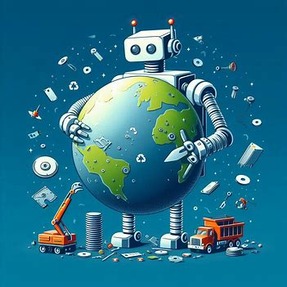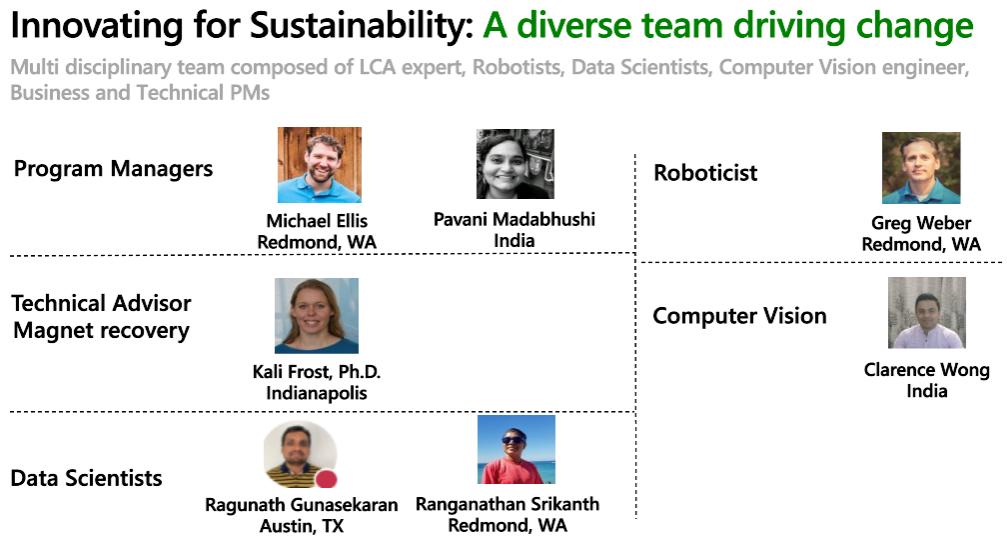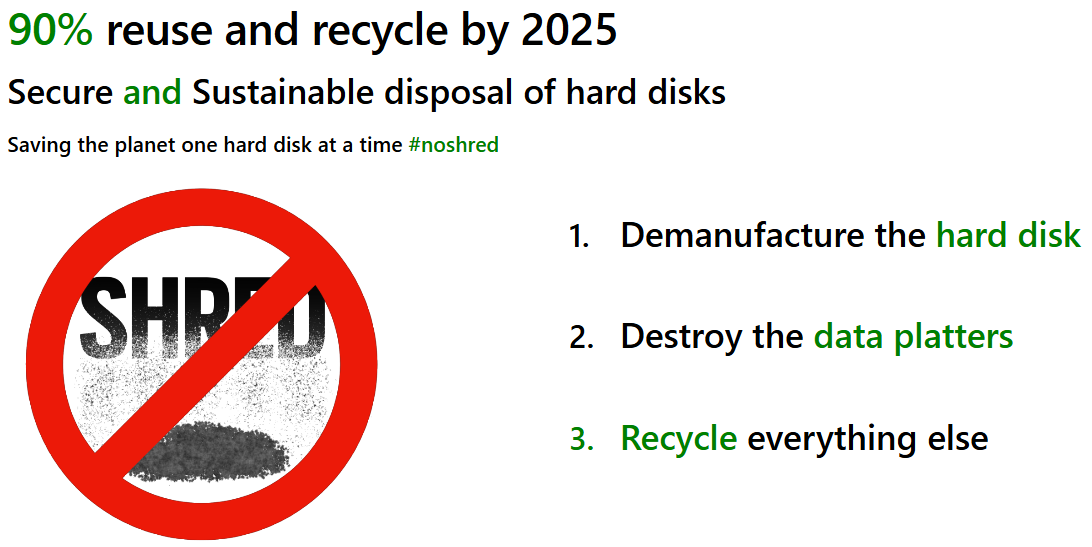Secure and Sustainable Disposal of Hard Disks
Saving the Planet One Hard Drive at a Time: How Robots are Kicking E-Waste to the Curb

“All of this began because one person couldn't stand the waste and pulled together a team of like-minded individuals to build a robot on a table in Building 92 one week in September 2022."
About Secure and Sustainable Disposal of Hard Disks
What if?
Every Microsoft Global Hackathon project starts with this simple question.
Data centers are no stranger to Microsoft’s Ranganathan Srikanth. As a Principal Data Scientist, they are a necessity in his day-to-day world. These facilities, housing computer systems and essential components like telecommunications and storage, use significant electricity—about 1-1.3% of global demand in 2022. With energy use expected to double by 2026, data centers, including those supporting cryptocurrency and AI, are putting increasing strain on local power grids – and when they reach the end of their lifespan, can wreak havoc on landfills if not disposed of properly.
In 2022, Srikanth took on an ambitious challenge at the Microsoft Global Hackathon in order to more effectively eliminate the potential threat to the environment and sensitive data. The project Secure and Sustainable Disposal of Hard Disks asked the bold question: “What if we could save the planet one hard drive at a time… with robots?”
“All of this began because one person couldn’t stand the waste and pulled together a team of like-minded individuals to build a robot on a table in Building 92 one week in September 2022,” said Ed Essey, Director of Business Value in the Microsoft Garage who also coached this team from its inception. But the road here actually began well before September 2022 when Microsoft first invented the Circular Center.
Circular Centers: A Revolutionary Concept
In 2020, Microsoft President Brad Smith had given the company a clear – and green – mission: make key changes today to ensure Microsoft will be carbon-negative by 2050. Inspired by this missive, Srikanth and his organization was determined to find a solution in an area they knew well: cloud data centers.
“Our business group responded by inventing ‘Circular Centers prior to Hackathon 2022,’” said Ranganathan Srikanth, project co-founder “These ‘Circular Centers’ are purpose-built to improve, reuse, and recycle cloud hardware.”
Microsoft Circular Centers aim to reduce e-waste from their datacenters by repurposing and recycling servers and related hardware. Utilizing machine learning, these centers will decommission servers onsite, sorting reusable parts for Microsoft, customers, or resale, and applying insights to improve future equipment sustainability. A pilot in Amsterdam demonstrated benefits like reduced downtime, increased availability of parts, and lower carbon emissions, with an expected increase in server and component reuse to 90% by 2025.
Assembling the Disassembly Team
Though these Circular Centers were a triumphant response to tackling the 50 million metric tons of e-waste produced globally each year from data centers, the problem was not entirely solved. Data centers have a depreciation/refresh cycle of three to five years, resulting in a consistent stream of electrical waste – a classification growing faster than any other category of solid waste. In addition to the environmental responsibility of disposing of this waste with care, Microsoft also has committed to running on trust, which translates to keeping every customer’s data safe. With Circular Centers, this means shredding every hard drive to protect sensitive materials from getting into the wrong hands.
“If it was just one hard disk, it wouldn’t be an opportunity. However, in 2022 alone, there were two million hard disks shredded and that would fill the cargo of up to nine 747s,” Srikanth illustrated during a coaching session.
Every year, between 20 to 70 million hard disk drives (HDDs) reach the end of commission, only to be scrapped, exposing data to theft, and wasting valuable metals like neodymium.
Srikanth saw the opportunity at hand, and began to build the Hackathon 2022 team, Secure and Sustainable Disposal of Hard Disks.
This diverse team, including program managers, data scientists, sustainability scientists, and a hobby roboticist, was driven by a startling reality.

What this Hackathon project developed was an improvement on the Microsoft Circular Center – a robot that sorts these parts which in turn makes the entire process more efficient and cost-effective while simultaneously building a reverse supply chain feeding into itself as recycled materials are reintroduced into the rhythm after responsible distribution.

The first objective was to stop the shredding of hard drives and instead pivot to disassembly. Security and sustainability together create a unique challenge when a data center’s hard drives are being decommissioned. To ensure that nefarious actors cannot access this private data, Circular Centers shred all the hard drives, then recycle that shredded material. But this team wanted to explore how the drives themselves could be recycled — and on a massive scale. Recognizing the precious materials being wasted, the team realized that achieving Microsoft’s sustainability goals would be impossible without addressing this issue. Through extensive research, they ultimately created robots that dismantle hard drives to recycle their valuable components. By destroying the data platters to prevent information leakage and recycling the remaining components, they hoped to revolutionize e-waste management. This approach not only benefits Microsoft but also has the potential to impact global practices, as companies worldwide manage large cloud centers and face recycling challenges.
The #NoShred Solution
The Secure and Sustainable Disposal of Hard Disks project aimed for their “#NoShred” solution to achieve a 90% reuse and recycle rate of all hard disks by 2025. This solution preserves the neodymium in hard disks, boosts recycling efficiency, ensures security compliance, and scales to meet the demands of cloud infrastructure. Hackathon 2022 was a crucial platform for testing their hypothesis and advancing their sustainability goals.
The Road Ahead
The journey began with a simple idea that evolved into a movement, garnering support from senior leaders, securing internal funding, forging partnerships with hard drive manufacturers, and collaborating with governments to influence e-waste management policies.
This project exemplifies one of the many initiatives aimed at creating a more sustainable, efficient, and resilient global cloud infrastructure. Its impact extends beyond the tech industry, making a substantial contribution to global sustainability efforts, as the challenges faced by data centers are universal. This breakthrough not only advances Microsoft’s goals but also fosters collaboration with other companies, offering this technology freely to prevent valuable materials from ending up in landfills and ensuring data security for all.
The Secure and Sustainable Disposal of Hard Disks project from Hackathon 2022 stands as a powerful example of what can be accomplished when passionate individuals unite to address complex challenges, all within the spirit of a global celebration of innovation.
About The Garage and Hackathon
This team’s focus on sustainability is just one of the many examples of Microsoft employees approaching the Hackathon with a profound question: *what if?* Some projects explore possibilities like enhancing global connectivity or making gaming more accessible. Across the world, teams are harnessing the Microsoft Global Hackathon to confront the most challenging “what ifs,” seizing the chance to follow their passions and empower people and organizations to achieve more.
Every day, The Microsoft Garage transforms these questions into tangible solutions, offering workshops, talks, hackathons, project coaching, and driving AI readiness across the company. As the hub of the Microsoft Global Hackathon, The Garage fosters collaboration and innovation on a global scale, uniting employees to generate ideas that inspire and drive transformation.
Learn more about how Microsoft employees in The Garage are changing our world every day by bookmarking our site and following The Garage on X and Instagram.
Team

